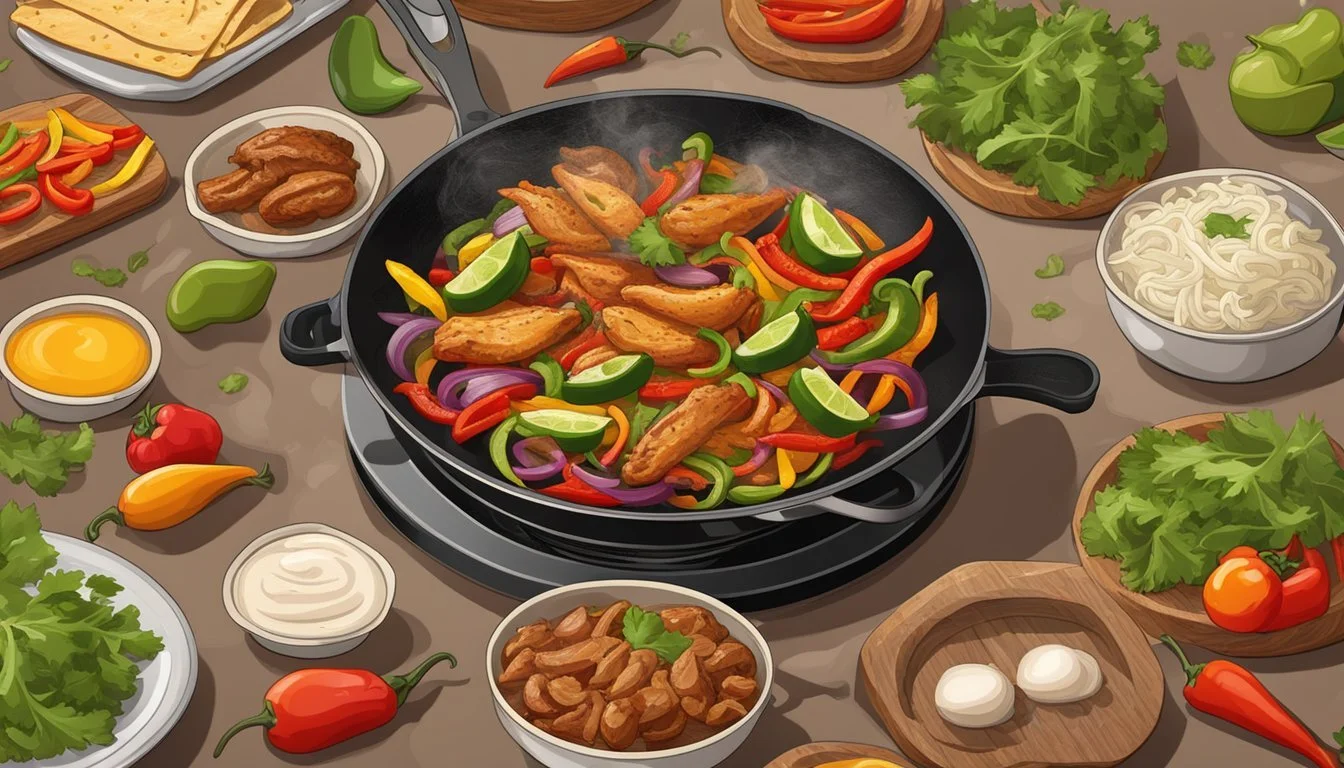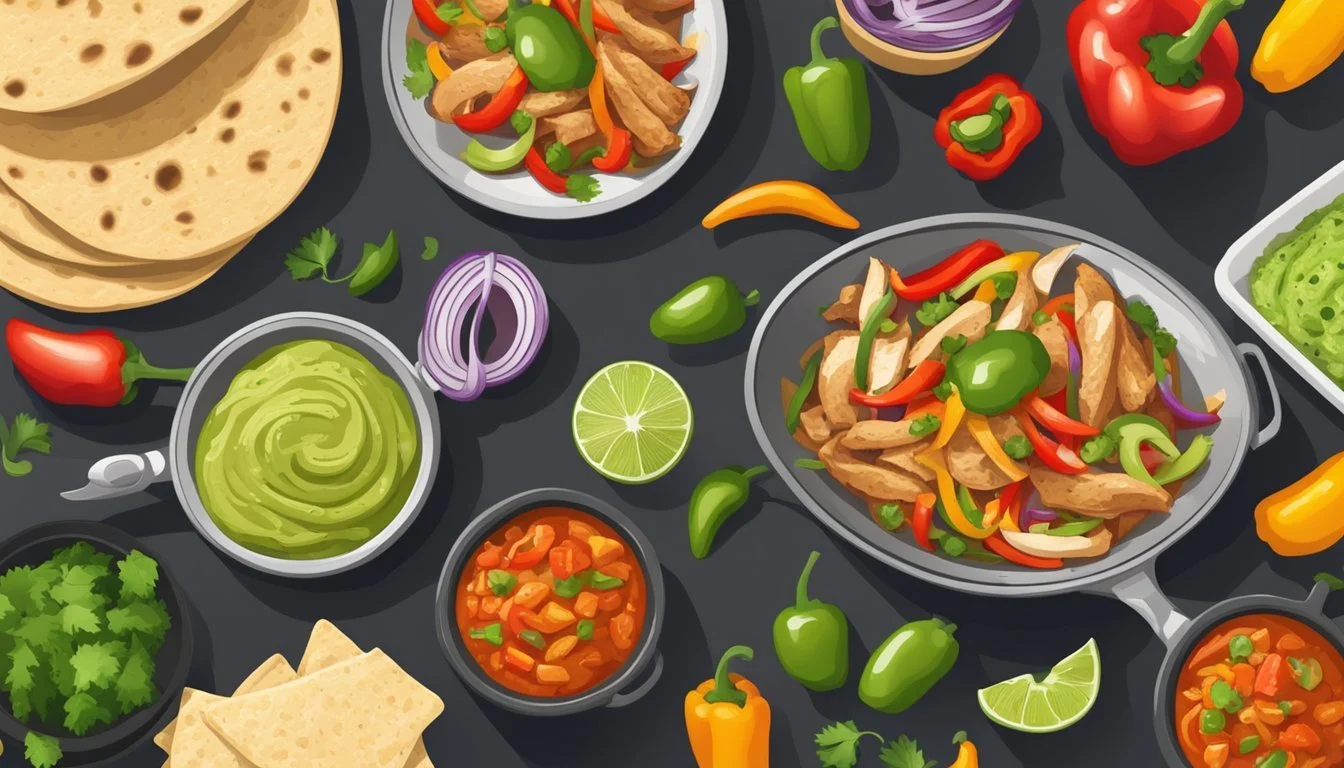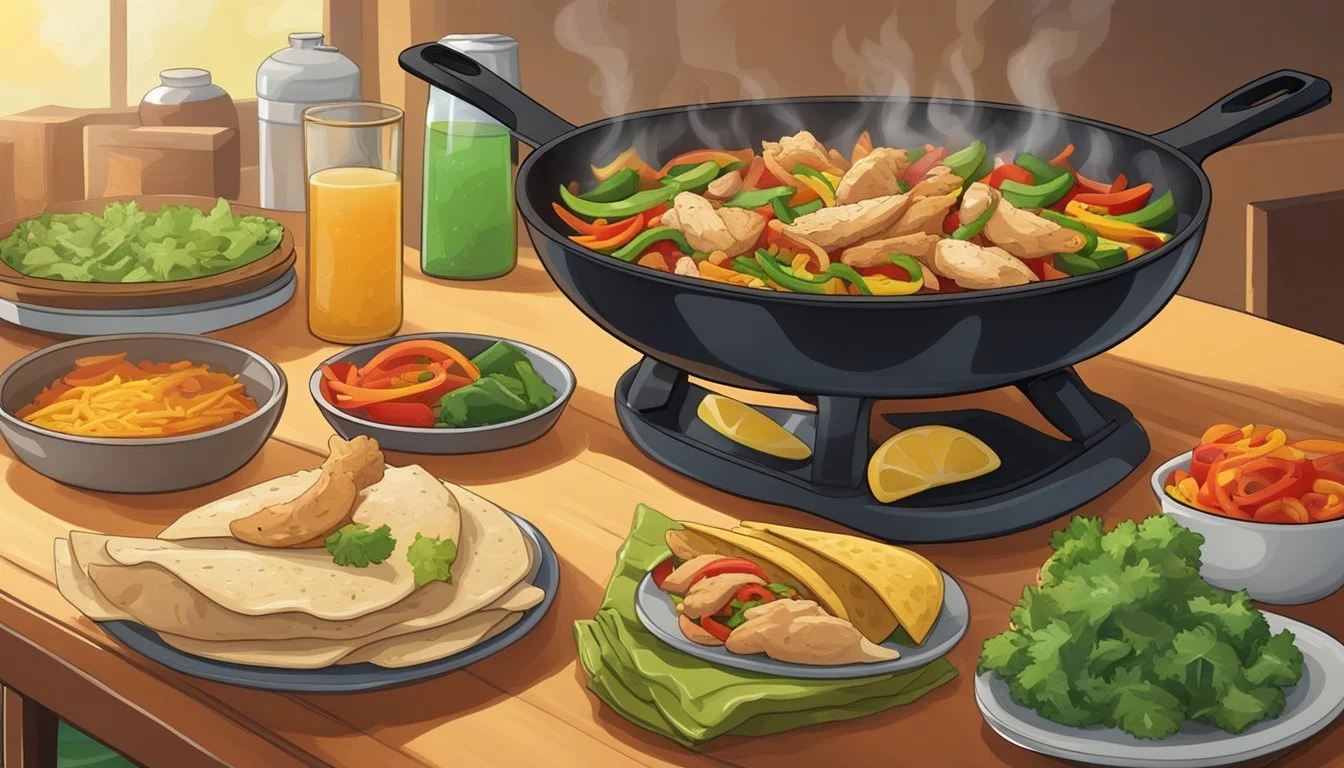How Long Do Chicken Fajitas Last?
Essential Storage Tips and Safety Guidelines
Chicken fajitas are a beloved dish, offering a delicious blend of spicy chicken, colorful peppers, and onions. For those who love to meal prep or simply want to ensure their leftovers don't go to waste, properly stored in an airtight container, chicken fajitas can last up to 3-4 days in the refrigerator. This makes them a convenient option for quick weeknight dinners or lunches.
Taking it a step further, many find it beneficial to freeze their chicken fajitas for longer storage. When placed in freezer-safe bags or containers and stored immediately after cooking, frozen chicken fajitas can remain good for 2-3 months. This not only preserves their flavor and texture but also ensures a ready meal whenever needed.
Whether refrigerating or freezing, reheating methods play a crucial role in preserving the taste and juiciness of the dish. Oven reheating is recommended for maintaining the fajitas' quality, ensuring the chicken remains moist, and the vegetables retain their crispness. With these tips, chicken fajitas can be enjoyed fresh and delicious, whether you've prepared them in advance or are savoring leftovers.
Understanding Chicken Fajitas
Chicken fajitas are a popular Tex-Mex dish made with seasoned chicken breasts or chicken thighs.
The meat is often cooked with an array of vegetables, including bell peppers and onions.
Typically served with flour tortillas or corn tortillas, this dish offers a balance of flavors and textures.
Ingredients:
Chicken: Common cuts include chicken breasts and thighs.
Vegetables: Bell peppers, onions.
Tortillas: Flour tortillas, corn tortillas.
Cooking Tips:
Chicken fajitas are usually cooked on a stovetop or grill.
It's important to cook the chicken until the internal temperature reaches 165°F.
Vegetables are sautéed until tender but still crisp.
Storage:
Refrigerator: Store in airtight containers. They can last 3-4 days.
Freezer: For longer storage, use freezer-safe bags.
They can be stored for 2-3 months.
Reheating methods include using the microwave or oven. Preheat ovens to 350°F and bake for 10-15 minutes until heated through.
Serving:
Chicken fajitas can be enjoyed in many ways.
They can be served with sides like rice, beans, or guacamole.
Variations in toppings can enhance the flavor profile, making each serving unique.
Preparing Chicken Fajitas
Preparing chicken fajitas involves selecting fresh ingredients, applying the right marinade and seasoning, and utilizing effective cooking methods to achieve a flavorful result. Each stage contributes to the overall taste and texture of the dish.
Selecting Ingredients
The key ingredients of chicken fajitas include chicken breasts, onions, and bell peppers. Choose fresh, boneless, skinless chicken breasts for the best results. Use a mix of red, yellow, and green bell peppers for a colorful presentation and to provide a diverse flavor profile.
Fresh onions add a sweet and aromatic element. Opt for yellow or red onions. Additionally, ensure that your vegetables are crisp and free from blemishes. Using fresh herbs like cilantro can also enhance the overall flavor.
Marinade and Seasoning
A good marinade is essential for infusing the chicken with rich flavors. A typical chicken fajita marinade includes lime juice, cumin, chili powder, garlic, and salt. The acidity from the lime juice tenderizes the meat, while the spices enhance its taste.
Mix the marinade ingredients in a large bowl or freezer bag. Coat the chicken breasts thoroughly and marinate for at least 30 minutes. For deeper flavor, marinate for a few hours in the refrigerator. You can also add a bit of vegetable or olive oil to the marinade for added moisture.
Cooking Methods
There are several ways to cook chicken fajitas. A cast iron skillet on the stovetop is preferred for its ability to retain and distribute heat evenly. Begin by heating the skillet over medium-high heat, then adding oil (vegetable or olive oil). Cook the chicken breasts until they reach an internal temperature of 165°F (74°C).
Sauté the onions and bell peppers in the same skillet. Use a metal spatula to scrape up the browned bits, mixing them with the vegetables. Cook until crisp-tender.
For a different approach, consider using a sheet pan for oven-baked chicken fajitas. Preheat the oven to 400°F (200°C). Spread the marinated chicken, onions, and bell peppers on the pan. Bake for about 20-25 minutes, or until the chicken is fully cooked.
To sum up, understanding these critical steps ensures your chicken fajitas will be flavorful and perfectly cooked.
Serving Suggestions
When serving chicken fajitas, various accompaniments can enhance the flavor and overall experience. Pairing the fajitas with tasty sides and fresh toppings can elevate the dish.
Accompaniments
Warm Tortillas
Chicken fajitas are typically served with warm tortillas. Heating the tortillas briefly on a skillet enhances their taste and makes them more pliable for wrapping.
Salsa
A fresh salsa can add a burst of flavor. Options range from classic tomato salsa to fruity variations like mango or pineapple salsa.
Guacamole
Guacamole, made from ripe avocados, lime juice, and fresh cilantro, provides a creamy texture that contrasts well with the fajitas.
Sour Cream
A dollop of sour cream adds a tangy, cooling effect that balances the spices in the fajitas.
Shredded Cheese
Shredded cheese like cheddar or Monterey Jack can be sprinkled over the fajitas for a rich, savory touch.
Lime Juice
A squeeze of lime juice over the fajitas just before serving brightens the flavors.
Fresh Cilantro
Lastly, garnish with fresh cilantro for a fragrant, herbal note.
These accompaniments ensure a vibrant and flavorful chicken fajita experience.
Storing Chicken Fajitas
Proper storage of chicken fajitas is critical to maintaining their freshness and preventing foodborne illnesses. Key storage methods include refrigeration and freezing, while also knowing how to detect spoilage is essential.
Refrigeration
Refrigerated Storage: Chicken fajitas should be stored in the refrigerator at a consistent temperature of 40°F (4°C) or below. Use airtight containers to minimize exposure to air and moisture, helping to preserve the fajitas' quality. Ensuring the containers are shallow allows for quicker cooling, which reduces the risk of bacterial growth.
Shelf Life: When properly sealed and refrigerated, chicken fajitas can last up to 3-4 days. It's advisable to label the containers with the date of storage to keep track of their shelf life. Keep the refrigerator clean and avoid cross-contamination by storing chicken fajitas separately from raw foods.
Freezing
Freezer Storage: For longer storage, chicken fajitas can be placed in the freezer. Separate the chicken and vegetables from the tortillas to prevent sogginess upon thawing. Store each component in airtight containers or wrap them tightly in aluminum foil before placing them in freezer bags.
Shelf Life: Properly stored in the freezer, chicken fajitas can maintain their quality for up to 2-3 months. Label the containers or bags with the date of freezing. When ready to consume, thaw the fajitas slowly in the refrigerator overnight to maintain texture and flavor.
Detecting Spoilage
Signs of Spoilage: It's crucial to inspect chicken fajitas before consuming. Odor: A sour or off smell is an indicator of spoilage. Texture: A slimy texture on the chicken or vegetables is another sign. Visual Inspection: Look for any mold growth or discoloration.
Preventive Measures: Consuming chicken fajitas within the recommended storage periods can help avoid foodborne illnesses. When in doubt, it's safer to discard any questionable leftovers.
Regularly checking and following proper storage guidelines ensures that chicken fajitas remain safe and enjoyable to eat.
Reheating Information
Reheating chicken fajitas properly is crucial to preserving their taste and texture. Methods vary, but ensuring safety and quality is paramount.
Safe Reheating Practices
Reheating chicken fajitas should always be done with food safety in mind. Ensure that the chicken reaches an internal temperature of 165°F (74°C) to kill any potential bacteria. The microwave is a quick option; use a microwave-safe plate and cover loosely to avoid moisture loss. Heat on high for 1-2 minutes, checking and stirring halfway through to ensure even reheating.
The oven offers a more even heat distribution. Preheat the oven to 350°F (175°C). Spread the fajitas on a baking sheet, cover with aluminum foil, and heat for 10-15 minutes. The stovetop method involves heating a pan with a small amount of oil, then tossing the fajitas for 3-4 minutes. Each method should be checked with a food thermometer to confirm the proper temperature.
Maintaining Quality
Maintaining the texture and taste of reheated chicken fajitas involves a few important steps. For microwaving, use a microwave-safe container and add a damp paper towel on top to keep the tortillas and filling moist. The result is a texture that closely resembles freshly made fajitas.
The oven method can be enhanced by drizzling a bit of water or broth over the fajitas before covering with foil to prevent dryness. The stovetop method tends to keep the flavors more vibrant. Add a bit of fajita seasoning while reheating to boost the taste. With all methods, stir or turn the fajitas halfway through the process to ensure even reheating.
Health and Safety
Proper storage of chicken fajitas is essential to avoid bacterial growth and foodborne illnesses. Store cooked chicken fajitas in airtight containers in the refrigerator. The refrigerator temperature should be consistently at or below 40°F (4°C).
Preventing Cross-Contamination: Use separate utensils and cutting boards for raw chicken and other ingredients. This minimizes the risk of spreading harmful bacteria.
Freezer Storage: Chicken fajitas can be frozen for up to 2-3 months in freezer-safe bags or airtight containers. Ensure the freezer is set to 0°F (-18°C) to maintain safety.
Reheating: When reheating chicken fajitas, ensure they reach an internal temperature of 165°F (74°C). This temperature kills most foodborne pathogens, reducing the risk of illness.
Leftovers: Consume refrigerated chicken fajitas within 3-4 days. Discard any leftovers left out at room temperature for more than 2 hours.
Handling Leftovers Safely:
Always wash hands before and after handling leftovers
Reheat only the portion you plan to eat
Avoid reheating multiple times as this can encourage bacterial growth
Signs of Spoilage:
Off smell or unusual colors
Slimy texture
These indicators means the chicken fajitas should be discarded to avoid the risk of foodborne illnesses.
Best Practices:
Label containers with storage dates
Avoid overstuffing the refrigerator; proper air circulation is crucial for maintaining temperature.
Adhering to these guidelines helps ensure chicken fajitas remain safe and enjoyable to eat.
Additional Tips and Tricks
For leftovers, store chicken fajitas in an airtight container in the refrigerator. This helps keep them fresh for up to 3-4 days. If you need to keep them longer, freeze them for up to 2-3 months.
When it comes to meal prep, separate the chicken and vegetables from the tortillas before freezing. This ensures that the texture and flavor remain optimal when reheated.
To reheat, place the fajitas in a microwave-safe dish and cover lightly with a damp paper towel. Heat for 1-2 minutes, stirring halfway through. Alternatively, reheat on the stove over medium heat until warmed through.
Consider making larger batches and portioning them out for quick weeknight meals. This makes it easy to have a delicious, ready-to-eat option on hand.
Versatile chicken fajitas can be enjoyed in various ways. Use them as fillings for tacos, burritos, or even as a topping for salads. This flexibility allows for creativity in the kitchen.
Adding fresh condiments like salsa, guacamole, or a squeeze of lime can enhance the flavors of reheated fajitas. These quick additions bring a burst of freshness to each meal.
Here’s a quick table for safe storage times:
Storage Method Duration Refrigerator 3-4 days Freezer 2-3 months
Quick tip: Always check for signs of spoilage before consuming leftovers. Look out for odors, slimy textures, and discoloration to ensure your meal is safe to eat.








